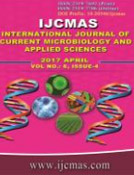


 National Academy of Agricultural Sciences (NAAS)
National Academy of Agricultural Sciences (NAAS)

|
PRINT ISSN : 2319-7692
Online ISSN : 2319-7706 Issues : 12 per year Publisher : Excellent Publishers Email : editorijcmas@gmail.com / submit@ijcmas.com Editor-in-chief: Dr.M.Prakash Index Copernicus ICV 2018: 95.39 NAAS RATING 2020: 5.38 |
A field experiment was conducted to study the response of green chilli to engineered constructed wetland treated wastewater in comparison to other sources of water at University of Agricultural Sciences, Dharwad, Karnataka, India during kharif 2015. Effect of six different sources of water (domestic wastewater, engineered constructed wetland-(ECWL) treated wastewater, borewell water, domestic wastewater alternated with fresh water, fresh water alternated with ECWL treated wastewater; domestic wastewater alternated with ECWL treated wastewater) was evaluated in green chilli. Application of domestic wastewater resulted in significantly higher fruit weight per plant (749 g/plant) in comparison to borewell water (541 g/plant) and ECWL treated wastewater (583 g/plant). Higher green chilli yield was recorded in the plot irrigated with domestic wastewater (17.58 t/ha) which was on par with application of ECWL treated wastewater alternated with domestic wastewater (16.28 t/ha); borewell water alternated with domestic wastewater (16.18 t/ha); fresh water alternated with ECWL treated wastewater (15.61 t/ha). Application of borewell water alone resulted in lower yield (13.31 t/ha). Domestic wastewater irrigation resulted in significantly higher water productivity (268.8 kg/ha-cm) as compared to fresh water (203.5 kg/ha-cm). Application of the domestic wastewater resulted in higher net returns and B: C ratio (Rs. 2,20,553/ha and 2.68) followed by alternative application of engineered constructed wetland treated wastewater and domestic wastewater (Rs. 1,94,463/ha and 2.48).
 |
 |
 |
 |
 |